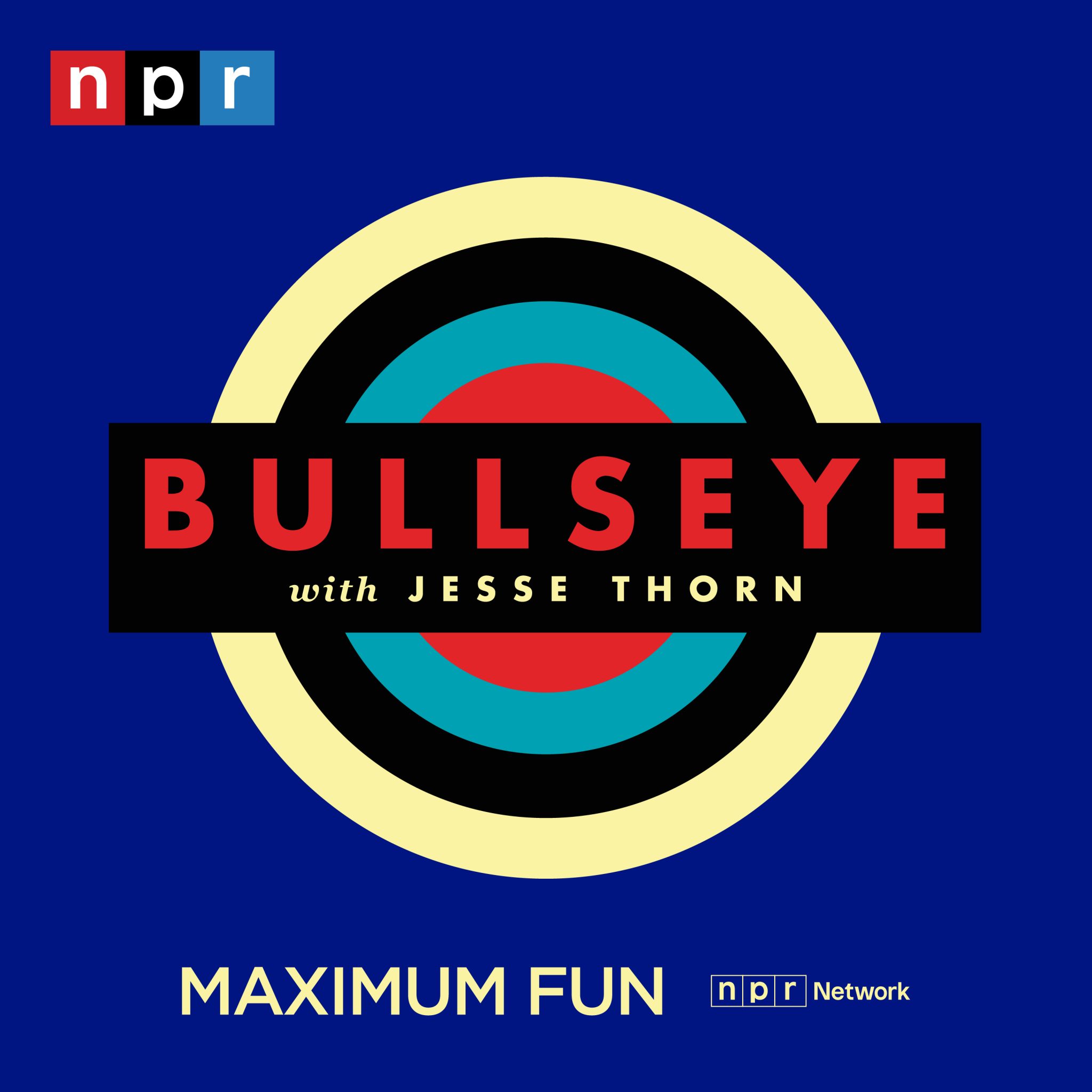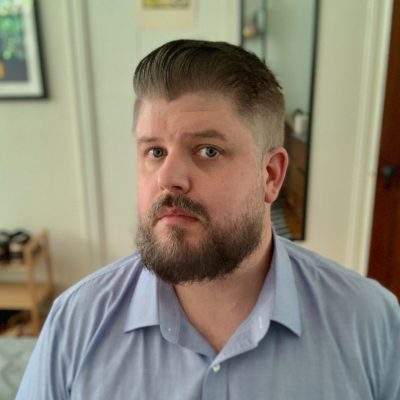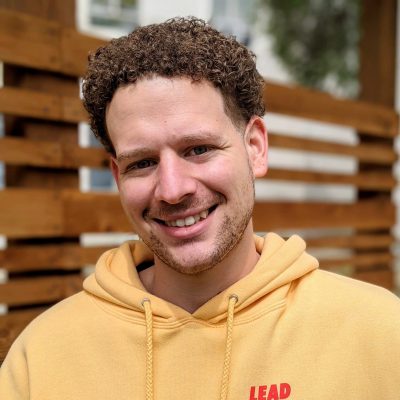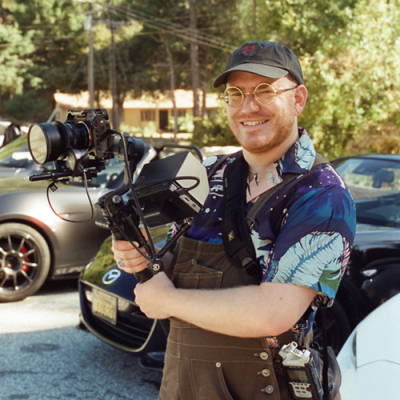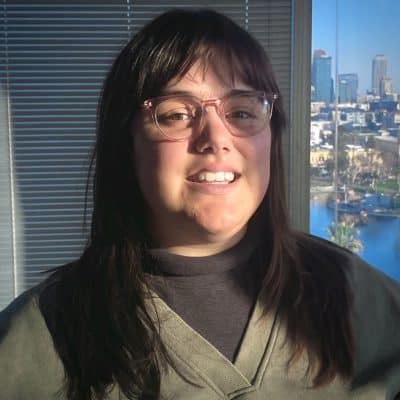Transcript
[00:00:00] Music: Gentle, trilling music with a steady drumbeat plays under the dialogue.
[00:00:01] Promo: Bullseye with Jesse Thorn is a production of MaximumFun.org and is distributed by NPR.
[00:00:14] Music: “Huddle Formation” from the album Thunder, Lightning, Strike by The Go! Team—a fast, upbeat, peppy song. Music plays as Jesse speaks, then fades out.
[00:00:27] Jesse Thorn: It is Bullseye. I’m Jesse Thorn. John Wilson carries his video camera everywhere. He carries it through his apartment as he’s cleaning his cat’s litter box, onto the subway, pointed at a loaf of bread that happens to be hanging from the handrail. In the park, he turns it on a person hanging from a tree. On the street, at a dog staring thoughtfully at a window. He takes all that footage, and he creates the show How to with John Wilson.
Each episode of How To makes a simple, straightforward promise to the viewer to teach them how to make small talk or cook the perfect risotto, how to appreciate wine. And then, (chuckles) each episode basically breaks that promise. John—the host, director, and principal cameraman—inevitably veers off course. He gets bogged down in his personal life. He stops to look at a big pumpkin. In one episode, which was originally about splitting a check at a restaurant, John went to a party where all the other attendees were referees. There is nobody like John Wilson, nobody making television as strange, compelling, fascinating, beautiful, and hilarious as John Wilson.
So, when we heard about the third and, sadly, final season of How To, we invited him back onto our show for a segment called “I Wish I Made That”. It’s a chance for guests to go in-depth about a piece of art that’s affected them so deeply—well, frankly, they’re jealous they didn’t make it. John Wilson is a lifelong New Yorker. He lives in Queens. He was raised on Long Island. When we asked him if there was something he wished he’d made, he picked a movie—a documentary, which is unsurprising. But that movie is, Los Angeles Plays Itself. It’s a documentary that—I mean, it’s not about New York! Here’s John Wilson.
[00:02:37] John Wilson: My name is John Wilson. I make a documentary TV show, called How to with John Wilson.
The movie I always wish that I made is called Los Angeles Plays Itself.
[00:02:48] Music: Bright, brassy music opens with an explosion of sound and continues under the dialogue.
[00:03:04] John Wilson: It is by this guy named Thom Andersen, who is also from Los Angeles.
[00:03:11] Clip:
Music: Heartfelt orchestral music.
Encke King: Sometimes I think that gives me the right to criticize the way movies depict my city. I know it’s not easy. The city’s big. The image is small. Movies are vertical—at least, when they’re projected on a screen. The city is horizontal except for what we call downtown.
(Sirens and horns.)
Maybe that’s why the movies love downtown more than we do.
[00:03:39] John Wilson: Thom Andersen is the—he’s a filmmaker and a film critic. He teaches or taught at Cal Arts. I was surprised to find out that the narrator in the movie wasn’t even him. You know, I—for the first five years after I saw it, I thought that Thom Andersen was narrating the entire thing. And I was like, oh wow, this guy has an amazing voice. You know, like I am so envious. It’s actually this other guy, Encke King, who is—you know, has a much more gravelly kind of trailer voice than Thom Andersen. And the narrator he chose for this movie is—it has a very soothing, relaxing voice. And it just—it’s almost like ASMR in a way.
[00:04:27] Clip:
Encke King: It’s elusive, just beyond the reach of an image.
(The sounds of cars and traffic.)
It’s not a city that’s spread outward from a center as motorized transportation supplanted walking, but a series of villages that grew together, linked from the beginning by railways and then motor roads. The villages became neighborhoods, and their boundaries blurred.
(A bell rings.)
But they remained separate provinces, joined together primarily by mutual hostility and a mutual disdain for the city’s historic center.
[00:04:59] John Wilson: An essay film usually involves some kind of narration. It can be personal sometimes, whether it’s memoir. It can be academic, like this movie is, where the writer is kind of studying a very specific thing.
[00:05:15] Clip:
Music: Thoughtful string music.
Encke King: Of course, I know movies aren’t about places. They’re about stories. If we notice the location, we are not really watching the movie. It’s what’s up front that counts.
[00:05:29] John Wilson: It’s a film with just a bunch of clips of movies shot in Los Angeles, and he narrates over all the clips and talks about how the city was represented, you know, from the beginning of Hollywood up until today through these various depictions. He has a take that I really like within it, that like the city—it’s one of the most filmed cities in the world. But you know, you don’t—you still don’t really have as a sense of place when you’re watching a film that’s shot in Los Angeles. It doesn’t have as many like landmarks. It doesn’t like have as much of an identity as New York or Chicago or something like that. But still, like there are these iconic parts of the city, like the Hollywood sign or Griffith Observatory or the Bradbury building that show up time and time again and are actually—actually do play themselves sometimes. I don’t know. This movie is just like candy to me.
[00:06:37] Clip:
Music: Gentle music overlaid with rain.
Encke King: Los Angeles may be the most photographed city in the world, but it’s one of the least photogenic. It’s not Paris or New York. In New York, everything is sharp and in focus, as if seen through a wide-angle lens.
(Shouting in the background. The music swells to a cacophony.)
In smoggy cities like Los Angeles, everything dissolves into the distance, and even stuff that’s close up seems far off. New York seems immediately accessible to the camera. Any image from almost any corner of the city is immediately recognizable as a piece of New York. Los Angeles is hard to get right.
[00:07:18] John Wilson: It’s a movie about Los Angeles, but I personally didn’t grow up there. I grew up mostly on Long Island. This movie kind of was the most panoramic kind of view of Los Angeles that I’ve ever had. I think I was 23 when I first saw this movie, so that was about 13 years ago. I didn’t realize that you could just put narration to imagery like this and create something really entertaining and deep. And it kind of changed the way that I see the moving image.
[00:08:02] Clip:
Encke King: Some buildings that look functional are permanent movie sets.
[00:08:05] John Wilson: One of the most memorable parts of this movie happens in the first quarter of it.
[00:08:12] Clip:
Encke King: A McDonald’s in the city of industry is never open to the public. Here, actors are paid so we can see them smile as they ingest their Big Macs.
[00:08:22] John Wilson: I just—I love the idea of this pristine fast-food place that is just—has never been enjoyed by anyone that actually lives there, you know, offscreen.
[00:08:37] Clip:
Encke King: A roadhouse at the corner of Avenue Q and 145th Street in Palmdale has never served a regular patron, but it appears prominently in Swordfish and Brother.
[00:08:48] John Wilson: What I love about this movie is that it kind of exposes each film within it and shows—it shows you all the smoke and mirrors involved in making like a car chase happen or a location something that it’s not. But what I really like is that this movie shows that the films within it actually serve a dual purpose as like documentaries of a place. You know, like it’s not just Bladerunner. Or you know, it’s not just LA Confidential. It is a documentary of this specific time and the way that like a lot of the architecture or the civic design is perceived. I feel like it ended up making me like the experience of watching these movies more, because I admire them more for their kind of documentary qualities now.
He spends a lot of time highlighting how kind of geographically inaccurate a lot of films are in Los Angeles, how you teleport from one place to another, and you’re expected to believe that it’s physically possible. Anyone from Los Angeles would realize that you couldn’t get there in time, but you know, they just try to use smoke and mirrors to disguise that. My favorite example was the original Gone in 60 Seconds, which came out in like 1974. They actually stick very close to the actual geography of the place as they’re chasing each other around.
[00:10:22] Clip:
(Speeding cars and police sirens.)
Encke King: And the best Los Angeles car chase movie is stubbornly, even perversely, literalist. Director Toby Halicki realized Dziga Vertov’s dream—an anti-humanist cinema of bodies and machines in motion.
(Motors rev. The sirens grow louder.)
His materialist masterpiece was the first manifesto for a cinema of conspicuous destruction. It was also the first Southern California movie centered in the South Bay—the unglamorous southern coastal region of the Los Angeles basin, stretching from Long Beach to El Segundo.
[00:11:00] John Wilson: I wish that I made this movie, because I just think it’s a perfect film. It’s got like a century of archival material. It’s just so smart, and it just feels—and it’s just so well written. It takes something that you’re really familiar with, and it kind of shows you the backside of it. It kind of strips it of all the narrative, you know, most of the time.
(Music fades in.)
It shows you what the historical purpose of each movie is, you know, after you’ve come to appreciate it for its like entertainment qualities.
[00:11:36] Clip:
Music: Playful percussive music.
Encke King: Once upon a time, visitors could take a guided tour and see how tires were made, just as today they can take a studio tour and see how movies are made.
[00:11:53] Jesse Thorn: John Wilson on the movie he wishes he’d made, Los Angeles Plays Itself. If you’ve never seen Los Angeles Plays Itself, you definitely should. It is an incredible movie. You can stream it on Canopy, which is usually free with your library card—at least, in most places. It certainly is here in LA.
The third and final season of How to with John Wilson is also great. I mean, it is a really, really special show. It’s so funny and amazing. Yeah. It is just like nothing else on television, and it’s not homework. It is a delight. So, catch that on HBO or on the streaming service Max.
(Music ends.)
[00:12:41] Transition: Bright music with a steady beat.
[00:12:45] Jesse Thorn: That’s the end of another episode of Bullseye. Bullseye is created from the homes of me and the staff of Maximum Fun, in and around greater Los Angeles, California—where we had an earthquake in the middle of a hurricane the other day. Uh, Los Angeles, left relatively unscathed, so thankful for that. But boy, that was really something!
Our show is produced by speaking into microphones. Our senior producer is Kevin Ferguson. Our producers are Jesus Ambrosio and Richard Robey. Our production fellow at Maximum Fun is Bryanna Paz. We get booking help from Mara Davis. Our interstitial music is by DJW, also known as Dan Wally. Our theme song is called “Huddle Formation”. It was written and recorded by The Go! Team. Thanks to them and Memphis Industries, their label, for providing it to us. Bullseye is also on YouTube, Twitter, and Facebook. You can follow us in all those places. If you enjoyed something that you heard on today’s show, please share it with somebody, because that is how people hear about our show.
And I think that’s about it. Just remember, all great radio hosts have a signature signoff.
[00:13:55] Promo: Bullseye with Jesse Thorn is a production of MaximumFun.org and is distributed by NPR.
About the show
Bullseye is a celebration of the best of arts and culture in public radio form. Host Jesse Thorn sifts the wheat from the chaff to bring you in-depth interviews with the most revered and revolutionary minds in our culture.
Bullseye has been featured in Time, The New York Times, GQ and McSweeney’s, which called it “the kind of show people listen to in a more perfect world.” Since April 2013, the show has been distributed by NPR.
If you would like to pitch a guest for Bullseye, please CLICK HERE. You can also follow Bullseye on Twitter, YouTube, and Facebook. For more about Bullseye and to see a list of stations that carry it, please click here.
Get in touch with the show
People
How to listen
Stream or download episodes directly from our website, or listen via your favorite podcatcher!
